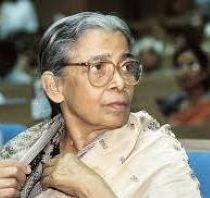Romila Thapar is a renowned Indian historian and author of many historical books. She has authored many internationally acclaimed books on history including From Lineage to State, Asoka and the Decline of the Mauryas, Early India: From Origins to AD 1300, and the popular History of India, Part I.

Thapar is an Honorary Fellow of the School of Oriental and African Studies, London, where she also received her Ph.D. in 1958, and a Foreign Honorary Member of the American Academy of Arts and Sciences. She was an emeritus professor of history at jawaharlal nehru university , New Delhi.
Thapar is a historian who believed in authenticity of historical data that is corroborated by archaeological evidences. Her historical writings delineate the origins of Hinduism as an evolving interplay between social forces.
Romila’s book From Lineage to State analyses the formation of states in the middle Ganga valley in the first millennium BCE, tracing the process to a change, driven by the use of iron and plough agriculture, from a pastoral and mobile lineage-based society to one of settled peasant holdings, accumulation and increased urbanisation. Her book on Somnath examines the evolution of the historiographies about the legendary Gujarat temple.
Thapar was a great critic of “communal interpretation” of Indian history, in which events in the last thousand years are interpreted solely in terms of a notional continual conflict between monolithic Hindu and Muslim communities. According to Thapar, this communal history is “extremely selective” in choosing facts, “deliberately partisan” in interpretation and does not follow current methods of analysis using multiple, prioritised causes.
Personal life
Romila Thapar was born 0n 30th November 1931 in lucknow,india as the daughter of Lieutenant-General dr.Dayaram thapar,the director general of Indian armed forces medical services. Young Romila ‘s education was in different cities of India as her father had to move as a military officer. She is an alumna of the St. Mary’s School and Wadia College, Pune. After doing her graduation from Punjab university in English literature she secured a second bachelors degree and later doctorate in history from the university of London in 1958.
Career
she started her career journey in Indian history as a reader at Kurukshetra university between 1961 and 1962 and later at Delhi university between 1963 and 1970. Thapar joined as professor of ancient Indian history at the Jawaharlal Nehru university, New Delhi later and continued in the university as Emeritus professor.
She has authored many books as a historian and her major works include:
- Asoka and the decline of the Mauryas
- Ancient Indian social history: some interpretations
- Recent perspectives of early Indian history
- A History of India volume one
- Early India: from the origins to ad 1300.
- From lineage to state.
Thapar’s first volume of a history of India narrates the period from its early history to the arrival of Europeans in the sixteenth century.
Ancient Indian social history gives an account of the period from early times to the end of the first millennium, and detailing a comparative study of Hindu and Buddhist socio-religious systems. It scrutinizes the role of Buddhism in social protest and social mobility in the caste system.
From lineage to state is a meticulous analysis about the formation of states in the middle Ganga valley in the first millennium B C and it traces the process to a change, driven by the use of iron and plough agriculture, from a pastoral and mobile lineage-based society to one of settled peasant holdings, accumulation and increased urbanisation.
Each book of Romila Thapar is an immersive account of historical narratives from a research-oriented perspective.
Honors & accolades
Romila Thapar is an honorary fellow at lady Margaret hall, oxford, and at the school of oriental and African studies (soas), university of London.
She holds honorary doctorates from the university of chicago, the institut national des langues et civilisations orientales in Paris, the university of oxford, the university of Edinburgh (2004), the university of Calcutta (2002) and recently (in 2009) from the university of Hyderabad.
Thapar was elected a foreign honorary member of the American academy of arts and sciences in 2009. She was also elected an honorary fellow of st Antony’s college, oxford, in 2017.
in 2004, the us library of congress appointed her as the first holder of the kluge chair in countries and cultures of the south.
She has been a visiting professor at Cornell university, the university of Pennsylvania, and the college de France in Paris.
She was elected general president of the Indian history congress in 1983 and a corresponding fellow of the British academy in 1999.
She is co-winner with Peter Brown of the Kluge Prize for the Study of Humanity for 2008.It is a very prestigious prize received by Romila Thapar. The prize is awarded by the John W. Kluge Centre at the Library of Congress.
in January 2005, she declined the Padma Bhushan awarded by the Indian government. Later she wrote to the president like this “i only accept awards from academic institutions or those associated with my professional work, and not state awards”.
Romila Thapar is considered as one of the intellectuals of Indian history who believes in doing justice to the nation’s history with a bold unyielding voice.
written by

Dr.Sanjana p. Souparnika
